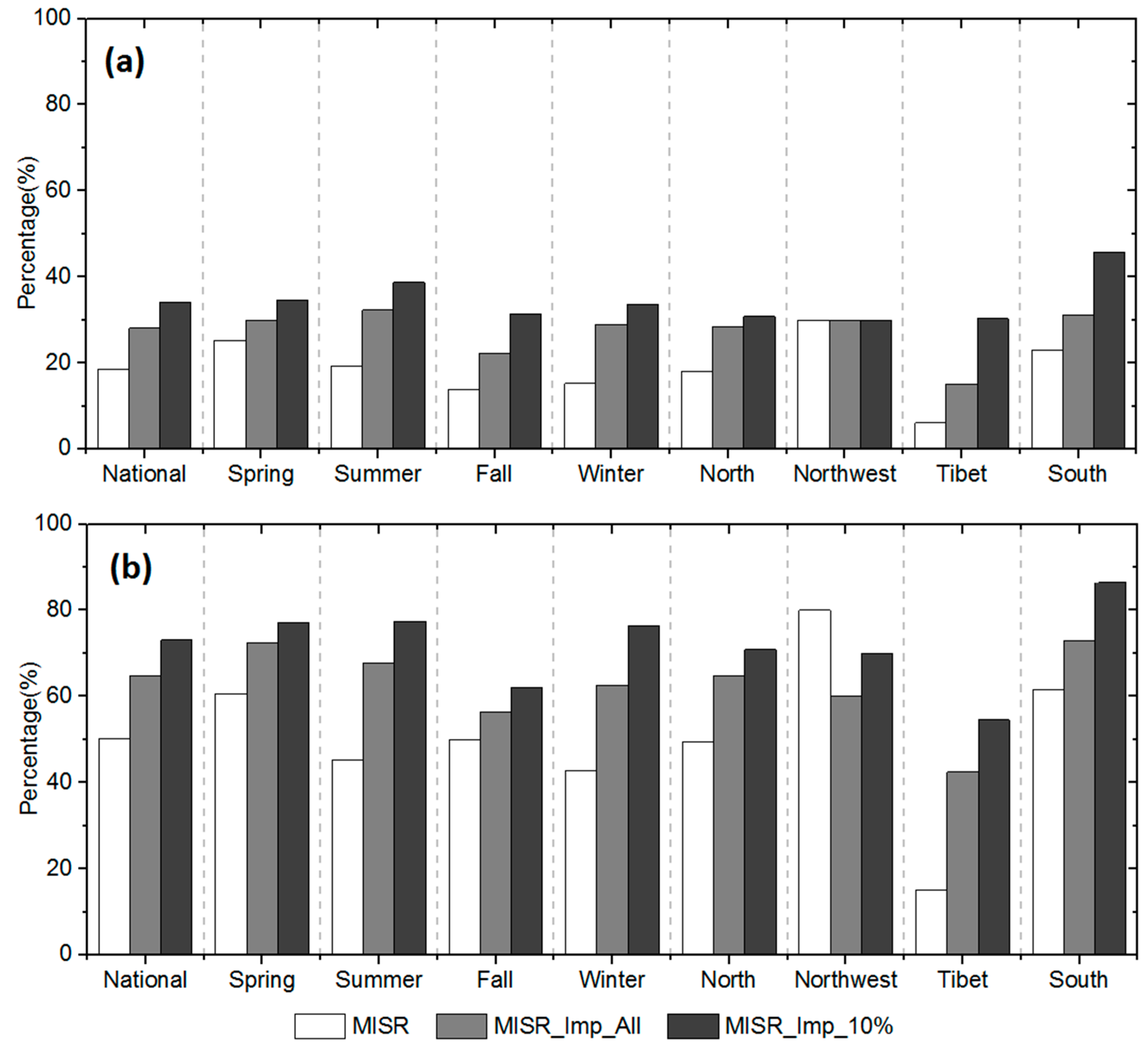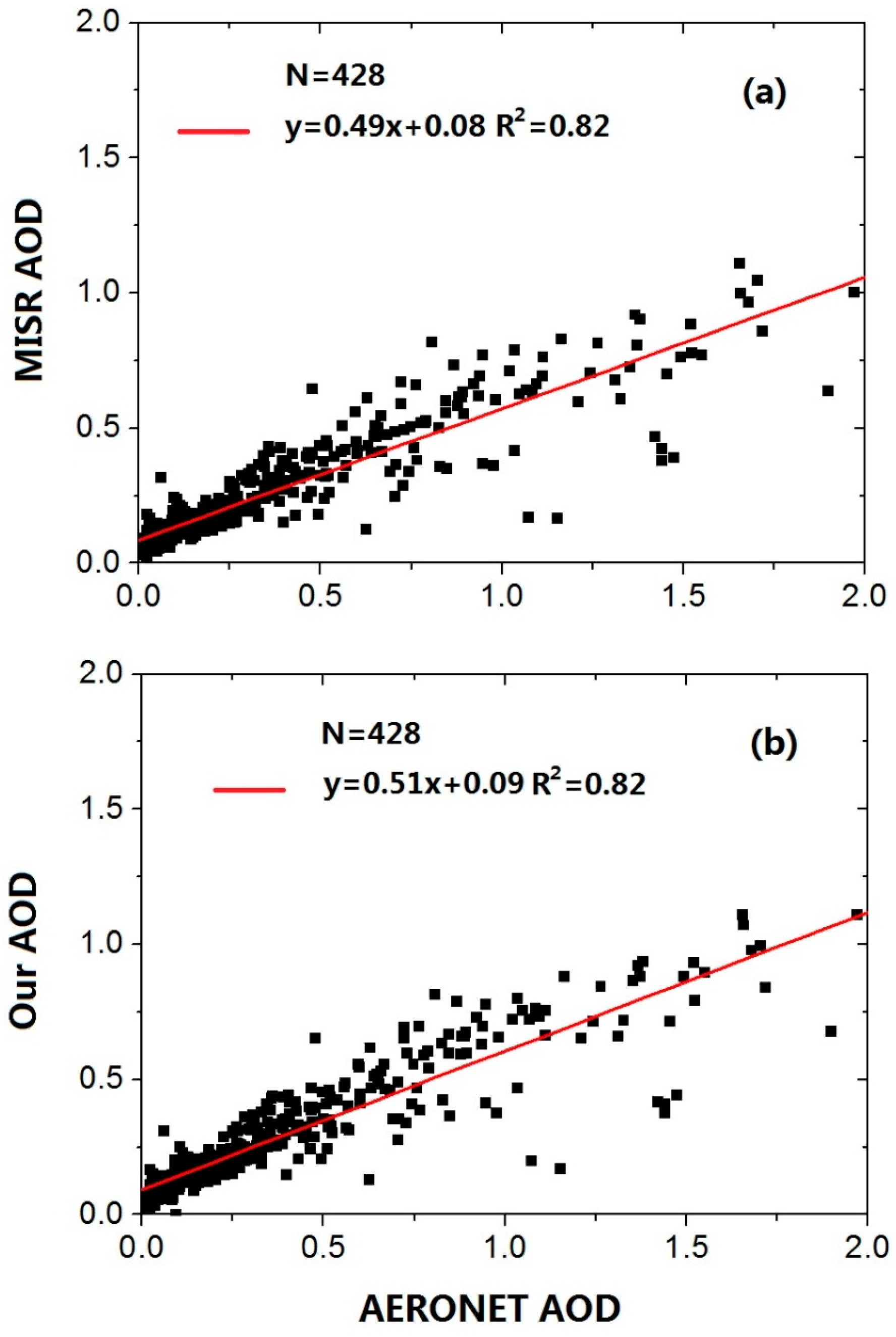1. Introduction
In China, rapid development and urbanization has led to severe haze pollution. However, the haze formation mechanism is still unclear because of the variety of precursor pollutants from natural and anthropogenic sources. Yang et al. concluded that the fine particulate matter (PM
2.5) present in most Chinese megacities is dominated by secondary aerosols, including sulfates, nitrates, and ammonium originating from local formation/production and regional transport [
1]. Li et al. demonstrated that the summer haze in northern China is usually caused by abundant organic matter and black carbon emitted by agricultural biomass burning [
2]. Wang et al. found that increases in spring dust in Beijing are derived from soils and caused by construction [
3]. To date, numerous epidemiological studies have associated China’s high levels of PM
2.5 with cardiovascular diseases [
4], ischemic heart diseases, lung cancer [
5], and obstructive pulmonary disease [
6]. Studies have focused on the adverse health effects caused by the total particle mass concentration, and the different toxicities related to the components, sizes, and absorbing properties of particle pollution have also been well investigated [
7]. For example, by comparing two highly exposed groups of healthy adults in Beijing, the elemental components of PM
2.5, including Si, Al, Ca, and Ti, were shown to have effects on lung function that had not been previously observed in analyses of particle levels alone [
8]. Compared with PM
2.5, an increase in the concentration of ultrafine particles (with diameters of 0.25~0.50 μm) shows a greater correlation with total and cardiovascular mortality [
9].
The particles within the haze usually range in diameter from 0.001 μm to 10 μm and present different absorbing/scattering characteristics. Therefore, mapping the quantitative distribution of aerosol optical properties represents an effective strategy for apportioning the source of PM
2.5 and evaluating the corresponding health effects. The aerosol optical depth (AOD) represents the integral of the extinction coefficient along the vertical path from the surface to outer space [
10]. The Angstrom exponent (AE) and single-scattering albedo (SSA) are two useful parameters for assessing the particle size and absorbing/scattering properties of atmospheric aerosols [
11], as well as the aerosol composition [
12,
13]. For example, aerosol mixtures dominated by dust absorption have monotonically increasing SSA with wavelength, whereas those dominated by black carbon absorption have monotonically decreasing SSA spectra, providing additional information on the composition of these aerosol mixtures [
14]. The absorption Angstrom exponent (AAE) values are near 1 for AERONET-measured aerosol columns dominated by urban-industrial aerosol, are larger for biomass burning aerosols, and are the largest for Sahara dust aerosols [
15]. Although the ground-based AErosol RObotic NETwork (AERONET) can measure the total-column AOD, AE, and SSA, the spatial coverage is very coarse. Satellite remote sensing is capable of filling in the gaps of ground-based observations; for example, the Moderate Resolution Imaging SpectroRadiometer (MODIS) on board the Terra and Aqua satellites has provided consistent and high-quality aerosol data for more than one decade, and the retrieved AOD is within an error range of ±0.05 ± 0.15
[
16]. However, many sensors similar to MODIS cannot capture the variability within the ground-truth particle size and absorbing/scattering properties [
17,
18]. MODIS usually misidentifies the aerosol dominated by coarse particles during dust events. As the successor to MODIS, the Visible Infrared Imaging Radiometer Suite (VIIRS) AE has been preliminary validated and demonstrates a limited ability to retrieve size parameters over land [
19]. In addition, MODIS and VIIRS cannot provide a quantitative estimate of the SSA with their standard aerosol products.
Since its launch in 1999, the Multi-angle Imaging SpectroRadiometer (MISR) sensor has proven to be as powerful as MODIS for the study of long-term spatial and temporal trends of aerosol optical properties and compositions [
20,
21]. MISR observes the atmosphere through effective path lengths ranging from one to three and through scattering angles of approximately 60° to 160° in the mid-latitudes. The unique multi-angle design of the MISR allows it to provide additional aerosol microphysical properties, such as the AE, SSA, and aerosol components, compared with other spaceborne sensors. This information has been shown to be highly effective in strengthening the association between the AOD and ground level PM
2.5 and its component concentrations [
22,
23]. Previous research has shown that AOD values obtained by the MISR and the powerful empirical orthogonal function (EOF) retrieval algorithm are consistent with ground observations and present a retrieval error of
or
[
24].
However, the MISR aerosol model also has limitations [
25], and the 74 aerosol mixtures cannot provide a description of global conditions. For example, the climatology of MISR Version 22 lacks spherical absorbing particles, as well as mixtures containing both spherical absorbing smoke analogs and non-spherical dust [
24]. Moreover, compared with the MODIS Dense Dark Vegetation (DDV) algorithm, which defines the prior aerosol optical properties using statistics from AERONET observations, MISR selects mixtures based on a set of chi-squared statistical tests, but does not correct them using prior knowledge. If many conflicting mixtures successfully pass the retrieval criteria, aerosol-type information retrieval is usually much poorer despite the robust AOD [
26]. Liu et al. reported an approximately 20% uncertainty in MISR-retrieved aerosol microphysical properties when distinguishing light-absorbing and non-light-absorbing aerosols [
27]. Li et al. found that MISR Version 22 data could not effectively distinguish between dust and water-soluble particles in the Chinese Taklimakan Desert and can lead to a low proportion of dust AOD [
26].
The MISR aerosol parameters AE and SSA have not been as widely investigated as the AOD. To the best of our knowledge, previous studies have not specifically focused on comparing and improving long-term MISR AE and SSA data with AERONET in China. Our current analysis aims to assess and improve the quality of MISR AE and SSA data for China over a long time frame. The remainder of this paper is organized as follows.
Section 2 describes the ground-based and satellite data products that are involved in this analysis, as well as the constraining methods.
Section 3 validates both the standard MISR product and our results using 11 years of AERONET observations. Finally,
Section 4 summarizes the major findings and potential future improvements of the current analysis.
4. Conclusions
In this study, the MISR AE and SSA values in China from 2004 to 2014 were validated for the first time using AERONET observations. The MISR showed a similar normal distribution, but demonstrated a lower mean of 0.09 0.43 compared with the AERONET AE. Our EE tests indicated that 18.46% and 50.23% of the MISR AE values were within the 0~0.1 and 0~0.3 envelopes of the MISR-AERONET absolute differences, respectively, on the national scale. In this study, a seasonal/regional scale was used to extract the minimum and maximum values, as well as the top 10% and the bottom 10% averaged values from the AERONET dataset, which included 11 years of AERONET data. Then, we developed a method that employs these two group thresholds as the constraining boundary conditions and calculated new AE values from the passed MISR mixtures. Overall, our national mean AE values from MISR_Imp_All and MISR_Imp_10% were closer to the AERONET AE than the original MISR product, even for different seasons and regions. In addition, the EE_0.1 and EE_0.3 tests between our AE and AERONET observations were improved from 18.46% and 50.23% (original MISR) to 28.04% and 64.72% (MISR_Imp_All) and 34.11% and 73.13% (MISR_Imp_10%), respectively. Our analysis showed that the strict constraints imposed by MISR_Imp_10% can ensure that most MISR mixtures are consistent with ground-based observations, although they could also filter out extra-fine and relatively coarse particles.
With regard to SSA values, the MISR exhibited an exponential-like distribution and showed many values close to 1.0, whereas AERONET displayed a normal distribution that ranged from 0.77 and 0.96. Our statistics showed that the MISR national mean SSA value (0.99) was significantly larger than the AERONET value (0.89), and seasonal or geographical variations were not observed in the MISR SSA distribution because of the high mean value. As a result, only 16.13% and 56.45% of the records were located in the EE_0.05 and EE_0.1 envelopes, respectively. Similar to the method used for the AE, our results for the 11 years of AERONET SSA data revealed that the MISR not only overestimates the real SSA, but also ignores highly absorbing particles in China. Overall, the mean values from our MISR_Imp_All and MISR_Imp_10% decreased to 0.96 and 0.94, respectively, whereas the MISR original product had a value of 0.99. Moreover, the EE_0.05 and EE_0.1 tests between our SSA and the AERONET observations were improved from 16.13% and 56.45% (MISR original product) to 40.32% and 70.97% (MISR_Imp_All) and 54.84% and 90.32% (MISR_Imp_10%), respectively. The analysis revealed that the strict constraint imposed by MISR_Imp_10% tends to include mixtures with low SSA values and further skews the final SSA closer to the AERONET values.
This study follows our previous works in the U.S., in which we improved the MISR AE and absorbing AOD values by employing the GOCART aerosol model simulations [
26]. The post-processing technique proposed in this analysis is directed at narrowing the selection of mixtures by introducing real AERONET observations. This approach does not require a validation of the GOCART model data. However, our method also has limitations. First, applying fine-scale aerosol optical properties from AERONET data is difficult; for example, it is difficult to use daily/grid aerosol simulations, such as those in the GOCART model, to constrain MISR mixtures. Second, because many regions of China lack coverage, as shown in
Figure 1, our current statistics may not represent the real aerosol properties over regions far from AERONET stations. Third, our approach is used for the improvement of AE and SSA and does not consider their intersection when selecting MISR mixtures. Nevertheless, the MISR retrieves a richer set of aerosol microphysical properties, which will allow us to develop more sophisticated techniques for selecting spatio-temporal constraints and aerosol types using ground-based measurement results.












